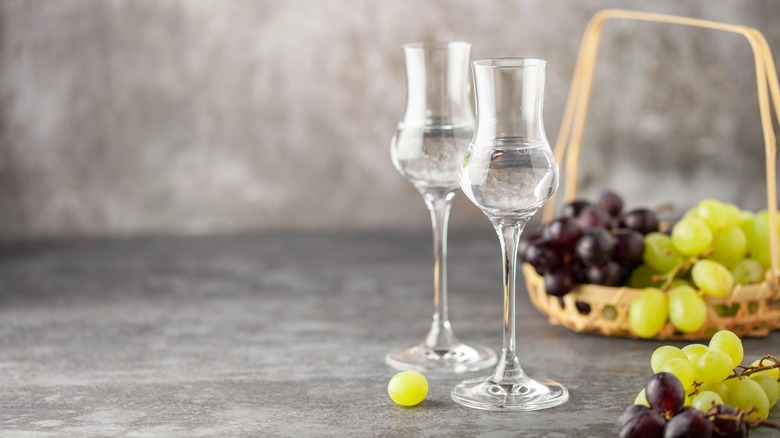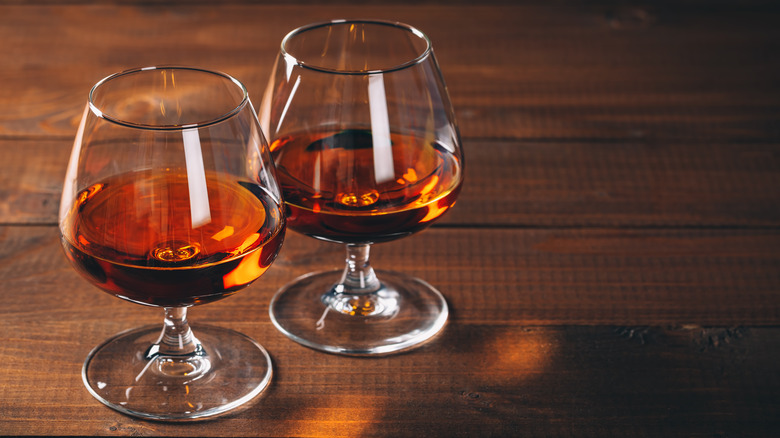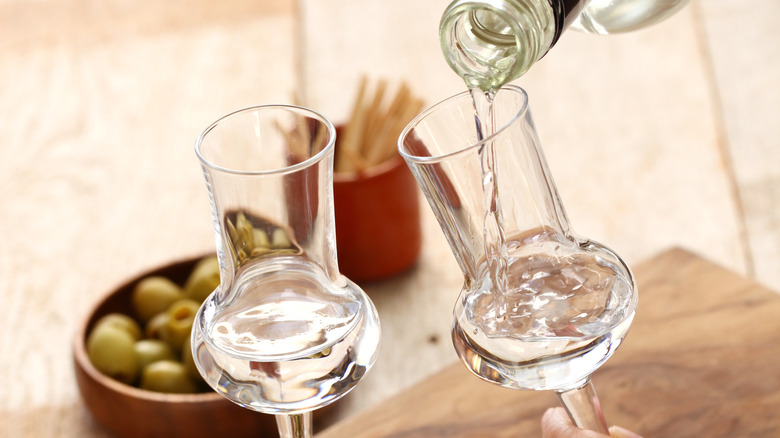What Makes Grappa Different From Brandy?
Spirits are produced from a wide variety of ingredients, delineated into several central categories. Grains create whiskey, agave forms tequila and mezcal, while fruit makes brandy. As you'd expect, this expansive category contains spirits of many flavors. Everything from the floral and herbaceous notes of pisco to the deep wood-tinged taste of a barrel-aged brandy fall under the brandy umbrella. So, knowing what is brandy and what isn't can get complicated.
If you've been to Italy — or a traditional Italian restaurant — and had a sip of grappa after a meal, you've tried yet another form of brandy. This spirit packs in enough special characteristics to distinguish it from other brandy types, which leads to confusion. Rather than fruit juice, grappa is made with the remnants of wine production — the skin, seeds, and stems – called pomace. Furthermore, it has a regulated definition confining production specifically to Italy. Throw in the fact that it can also be aged or flavored, and it's evident that grappa is a nuanced substyle in itself.
What is grappa?
Intertwined with northern Italy, grappa's roots trace back centuries, possibly as far back as the 2nd century. For most of its existence, the spirit has been associated with humble roots by way of its bracing boozy palate and utilization of winemaking byproducts. Today, grappa follows an elaborate and regulated process that produces a liquor with incredible complexity. Flavor notes vary from light aromatic fruit, to nuttiness, and tinges of sweetness, showcasing the unique characteristics of the utilized grape remnants. Occasionally, it's made from only a single grape varietal, expressing the fruit's specific characteristics. Plus, grappa can be aged in barrels, imparting an oaky character. The liquor's strength ranges from 70 proof all the way up to 120 proof.
Traditionally, grappa uses steam for distillation. The result may not even be watered down, which furthers intensity. Nevertheless, some modern producers have turned to continuous stills to create larger volumes, too. Once distilled, grappa is either kept in steel tanks or aged in barrels; depending on the producer, this might be for less than a week or up to a year and a half or more (and in rare cases, decades). Like with cognac, the aging duration delineates it into several named categories. While most often served straight, grappa does appear in delicious Italian cocktails.
What is brandy?
Brandy is an encompassing term: It simply refers to a spirit made from fruit. Grapes are the most frequent base, but stone fruits like apricots and cherries, as well as apples are also common. Varieties of the liquor are made worldwide, available in both barrel-aged, and clear forms. Many are further segmented into regional styles, often upheld by regulation regarding production.
Past its general use of fruit, there's no strict definition for brandy's composition. As a result, the liquor is occasionally mixed with sweeteners to lower its ABV. Alternatively, it can also be distilled into stronger varieties, topping 50% ABV. Due to such a wide range, most brandies are referred to by the name of their substyle. You've likely heard of popular types like cognac, pisco, rakia, and applejack (not to be confused with apple brandy). Grape-based brandies are more often aged and blended together, lending them some similarity to whiskey. However, there are also unaged grape-based brandies — with grappa being one such example.
In addition to it sipping neat, brandy has been utilized since the inception of cocktail culture. The best brandy cocktails showcase the spirit in malleable forms, from the boozy Vieux Carré, to the tart pisco sour. Such frequent use in the shaker furthers brandy's indispensable appearance on the bar shelf.
Grappa is different from other pomace brandies
Since brandy is most often made from fruit juice — not wine production remnants — grappa is distinct from other spirits in the category thanks to its strong identity and protected production process. Nevertheless, pomace-based alcohols are included in the category, and there's a delicious range to sample.
Firstly, the grappa name is only regulated in the European Union, where it must be produced in Italy, the Italian part of Switzerland, or San Marino. Note that in the United States, such regulation doesn't apply, so pomace-based spirits made in America that emulate the style can still be sold as grappa.
Furthermore, there are other regional spirits similar to grappa. In fact, pomace brandies are distilled in many countries with storied wine-making traditions. Greek winemakers produce tsipouro, which also comes with a regional regulation. In the country of Georgia — where winemaking goes back centuries — chacha is a similarly crafted liquor. Meanwhile, remnants from wine production in Burgundy, France are turned into a spirit called eau-de-vie de marc. And you'll also find pomace brandy from Portugal called bagaço. So, while grappa is a celebrated Italian style of liquor, it's far from the only pomace brandy on the market.



